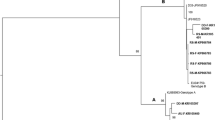Abstract
Clinical manifestations of Giardia duodenalis infection vary from asymptomatic infection to chronic diarrhoea. We study the correlation between the presence of symptoms and the G. duodenalis genotype in 108 patients with giardiasis. Patient age ranged from 2 to 72 years old. We found a correlation between assemblage AII and symptomatic infections, and between assemblage B and asymptomatic infections in the overall patient group and in patients less than five years of age. Nevertheless, if only patients of more than five years of age were considered, no statistically significant relationship between assemblage and symptomatic or asymptomatic Giardia infections was found. In these patients, host factors may affect the presence of clinical manifestations more than Giardia assemblage.
Similar content being viewed by others
References
Thompson RCA, Hopkins RM, Homan WL (2000) Nomenclature and genetic groupings of Giardia infecting mammals. Parasitol Today 16:210–213
Thompson RCA (2004) Epidemiology and zoonotic potential of Giardia infections. In: Sterling CR, Adam RD (ed) World class parasites, vol 8: the pathogenic enteric protozoa: Giardia, Entamoeba, Cryptosporidium and Cyclospora. Kluwer Academic Publishers, Boston, Massachusetts, pp 1–14
WHO (1996) The World Health Report 1996. Fighting disease, fostering development. World Health Organization, Geneva, Switzerland
Thompson RCA (2000) Giardiasis as a re-emerging infectious disease and its zoonotic potential. Int J Parasitol 30:1259–1267
Homan WL, Mank TG (2001) Human giardiasis: genotype linked differences in clinical symptomatology. Int J Parasitol 31:822–826
Read CM, Walters J, Robertson ID, Thompson RCA (2002) Correlation between genotype of Giardia duodenalis and diarrhoea. Int J Parasitol 32:229–231
Haque R, Roy S, Kabir M, Stroup SE, Mondal D, Houpt ER (2005) Giardia assemblage A infection and diarrhea in Bangladesh. J Infect Dis 192:2171–2173
Boom R, Sol CJA, Salimans MMM, Jansen CL, Wertheim-van Dillen PME, van der Noordaa J (1990) Rapid and simple method for purification of nucleic acids. J Clin Microbiol 28:495–503
Amar CFL, Dear PH, Pedraza-Díaz S, Looker N, Linnane E, McLauchlin J (2002) Sensitive PCR-restriction fragment length polymorphism assay for detection and genotyping of Giardia duodenalis in human feces. J Clin Microbiol 40:446–452
Acknowledgments
This work was supported by Gobierno de Aragón, Grupos Consolidados A26.
Author information
Authors and Affiliations
Corresponding author
Rights and permissions
About this article
Cite this article
Sahagún, J., Clavel, A., Goñi, P. et al. Correlation between the presence of symptoms and the Giardia duodenalis genotype. Eur J Clin Microbiol Infect Dis 27, 81–83 (2008). https://doi.org/10.1007/s10096-007-0404-3
Published:
Issue Date:
DOI: https://doi.org/10.1007/s10096-007-0404-3




